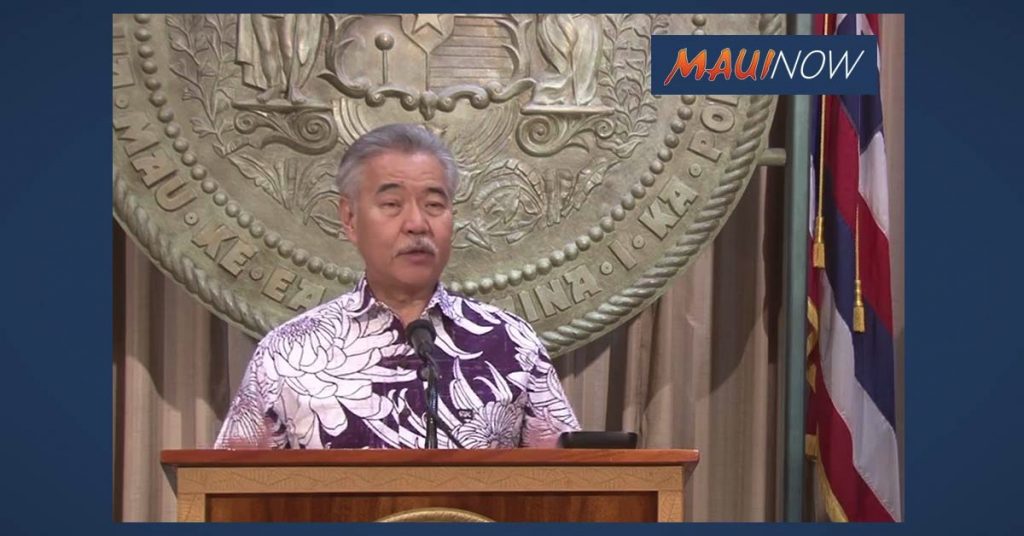

Governor David Ige gave an update today on the state’s COVID-19 vaccination efforts, saying that health workers, residents and staff in nursing homes are currently being vaccinated. The second doses of the vaccine have started to come in and will be administered.
In addition, first responders, front-line workers, and people 75 and older are also starting to receive the vaccine.
After that, the next phase will include vaccination for people over 65 years old. It also includes those over the age of 16 at high risk for COVID-19 complications and other essential workers. In the early summer, according to the state’s plan, the vaccine will be open to all members of the community.
(A full breakdown of who is included in each stage and when the stage will be rolled out is given by scrolling down in this article).
Gov. Ige said, “I ask everyone to remain vigilant and to continue the safe practices that have made Hawai’i a leader in fighting the spread of COVID-19: wearing masks, washing hands, and keeping an eye on distances. By doing this – and by getting vaccinated when it is our turn – we can protect public health, revitalize the economy and strengthen our communities. “
Those who may be eligible for the vaccine but are not affiliated with a specific health care facility or employer are asked to make sure to visit the state’s website hawaiicovid19.com in the coming days. State officials say there will be links and more guidance in the coming weeks where the public can click on ‘I need / want a vaccine’ and be guided for further instructions. The state will also set up a telephone line where people can make calls.
Hawai’i Lieutenant Governor Josh Green said the state will accelerate distribution in about two weeks for those who fall into the Phase 1b category. He said the second week of January is expected to be a time when the federal government and its supply chain can give Hawai’i more vaccine each week.
“It has already begun, and we have begun to vaccinate some individuals in that category, including first responders,” said Lt. Gov. Green, noting that Hawai’i can gain immunity if about 75 to 80 percent of the population is vaccinated.
According to Lt. Gov. Green found in a recent state poll that about 55 percent of respondents said they would absolutely want to get vaccinated, and another 25 percent said they are open to being convinced.
“I think 80 percent of our population will eventually get the vaccine – that’s 80 percent of 1.4 million – that’s over a million people,” he said.
To date, the state has received more than 82,000 vaccination doses. Lt. Gov. Green said the state expects to receive 25,000 doses this week. The projection he said, based on information shared with the state so far, plans to receive 150,000 doses every month at some point in the future.
There are an estimated 609,000 people together who fall into phases 1 a, b and c, and large-scale sites are currently being set up for the distribution effort.
Lt. Gov. Green said, “Our number one priority is to keep everyone safe while working as quickly and efficiently as possible to use the vaccine and get it out the door and in the arms. We ask for everyone’s patience as we, and the world, take on this monumental task. “
Phase 1a: December 2020 – January 2021
- Healthcare workers: paid and unpaid personnel working in healthcare settings who may be directly or indirectly exposed to patients or infectious material. (Estimated total: 40,000)
- Residents of a long-term care facility: Adults staying in facilities that provide a variety of services, including medical and personal care for those unable to live independently. (Estimated total: 10,000)
Phase 1b: December 2020 – March 2021
- Hawai’i Inhabitants Age 75+: Adults over 75 years old (estimated total: 109,000)
- Frontline workers: Employees whose duties must be performed on site and who must be close to the public or colleagues are at significantly higher risk of exposure to SARS-CoV-2 and are essential to the functioning of society with special attention to life and safety first. This includes: first responders; correction officers and personnel; dispatchers of emergency services; individuals essential to federal, state, and local government activities; workers in critical transport infrastructure (port and dock workers, public transport, etc.); critical supplies (energy, water, etc.); childcare and educational support teachers and staff (childcare, kindergarten, pre-primary, K-12, post-secondary, etc.); Employees at US Postal Service. (Estimated total: 50,000)
Phase 1c: To be determined: March – May 2021 (estimated total: 400,000)
- Hawai’i Residents Age 65+: Adults ages 65-74
- Individuals with underlying medical conditions: Individuals of all authorized ages who are eligible for vaccines with co-morbid and underlying conditions that pose an increased risk of serious COVID-19.
- Other essential employees: essential employees not included in phase 1b
additional considerations
- The distribution of the vaccine can take place simultaneously between the phases
- Within each phase, vaccinations are distributed among the populations that have the highest priority first and then in order of descending age
- Vaccinations can be redistributed if significant outbreaks or clusters occur
- Priority groups can be extended to others if deemed necessary to limit the spread of disease, disease or mortality
- Where possible, vaccination can be disseminated to geographic priority populations, taking into account current disease activity, disproportionately affected communities and health and socio-economic vulnerabilities
Phase 2 and 3
General population vaccination is expected to begin in early summer 2021, subject to manufacturing and federal dose allocation through “Operation Warp Speed.”